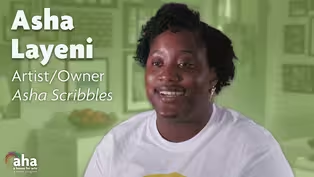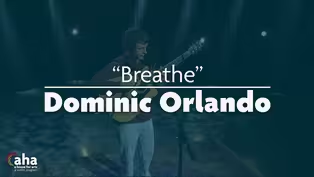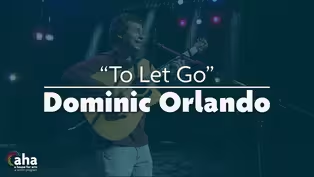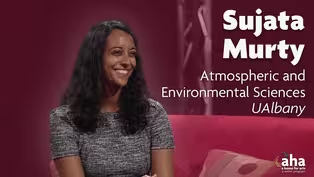
AHA! | 713
Season 7 Episode 13 | 27m 45sVideo has Closed Captions
Asha Layeni's love of drawing, Sujata Murty love of the arts, and Dominic Orlando performs
Asha's drawings celebrating the beauty of black women have since turned into a creative business: Asha Scribbles. How does someone use their life-long love for the arts to study geochemistry and help battle climate change? Lara Ayad sits down with SUNY Assistant Professor Sujata Murty to find out. Local singer/songwriter Dominic Orlando performs some beautiful music on his acoustic guitar.
Problems playing video? | Closed Captioning Feedback
Problems playing video? | Closed Captioning Feedback
AHA! A House for Arts is a local public television program presented by WMHT
Support provided by M&T Bank, the Leo Cox Beach Philanthropic Foundation, and is also provided by contributors to the WMHT Venture Fund including Chet and Karen Opalka, Robert & Doris...

AHA! | 713
Season 7 Episode 13 | 27m 45sVideo has Closed Captions
Asha's drawings celebrating the beauty of black women have since turned into a creative business: Asha Scribbles. How does someone use their life-long love for the arts to study geochemistry and help battle climate change? Lara Ayad sits down with SUNY Assistant Professor Sujata Murty to find out. Local singer/songwriter Dominic Orlando performs some beautiful music on his acoustic guitar.
Problems playing video? | Closed Captioning Feedback
How to Watch AHA! A House for Arts
AHA! A House for Arts is available to stream on pbs.org and the free PBS App, available on iPhone, Apple TV, Android TV, Android smartphones, Amazon Fire TV, Amazon Fire Tablet, Roku, Samsung Smart TV, and Vizio.
Providing Support for PBS.org
Learn Moreabout PBS online sponsorship(upbeat music) - [Lara] Scribble artist Asha Layeni celebrates the beauty of black women.
Sujata Murty reveals how art and science can be powerful allies.
And catch a performance from Dominic Orlando.
It's all ahead on this episode of AHA, A House for Arts.
- [Narrator] Funding for AHA has been provided by your contribution and by contributions to the WMHT venture fund.
Contributors include The Leo Cox Beach Philanthropic Foundation, Chet and Karen Opalka, Robert and Doris Fischer Malesardi, The Alexander and Marjorie Hover Foundation and The Robison Family Foundation.
- At M&T Bank we understand that the vitality of our communities is crucial to our continued success.
That's why we take an active role in our community.
M&T Bank is pleased to support WMHT programming that highlights the arts, and we invite you to do the same.
(upbeat music) - Hi, I'm Lara Ayad and this is AHA, A House for Arts, a place for all things creative.
Here's Matt Rogowicz with today's field segment.
- I'm here in Mariaville, New York, to visit the studio of Asha Layeni, who's turning her scribbles into a creative side hustle.
Follow me.
(upbeat music) - My name is Asha Layeni.
I am the owner / artist of Asha Scribbles.
It's a year-old art business.
I just finished a collection called the Beauty of Black Girls.
That was really just because I was sort of frustrated that I didn't see people that looked like me in art, especially in like, when you go to like stores and stuff, like Walmart.
So I was like, well, where are the people that look like me?
So I was like, well, I guess I'll create it.
I'm actually an education major at The College of Saint Rose in Albany.
And I'm actually doing my student teaching.
That's pretty much my day job, and then I guess my night job would be doing art.
Last year in the pandemic, like everyone else, I was home.
I had school, but that was online.
And I was literally looking at the four walls of my house pretty much day in, day out.
And, like everyone else, I was super bored.
And I was like, well, what is there something that I can do that, you know, will take up my time and keep me busy.
I was like, well, you've always liked to draw.
I was like scrolling through Instagram one day and I saw this artist and I was like, I can do that.
And that's pretty much how it started.
Originally, it was gonna be Asha Draws, but I felt like that was kind of too cliche, kind of played out.
I was like, well, what's something that's drawing but not really.
So then I like plugged into Google, like synonyms nickname draw.
Yeah, so, and that's how I came up with Scribble really.
And so I started with the sketch, you know, figure out what exactly is that I want it to look like.
And then that's when I do the outline, clean it up a little bit, you know, make sure things look what it's supposed to look like.
Besides thinking and trying to figure out what you're coming up with, I would say the other longest part of my process is the actual color.
I'm picking out my palette, trying to figure out, like, okay, what do I want the colors to look like, especially if it's an actual human person that's supposed to look realistic.
There's a lot of colors in the skin that people don't realize that there are, even if you are quote unquote white or black, you still have like seven different colors in your skin.
So me trying to figure that out is a lot of trial and error.
And then, I do finishing details.
And I kind of like the details, 'cause then it makes it come alive, so you know, you do the blush and all just like the little things like where the light hits.
All my pieces are my favorite.
But my favorite piece so far, I would say, is my Sade portrait.
I did a watercolor portrait of Sade.
Another one, I would say my grandparents.
I have a series about like little black children, and so it's called cocoa butter babies.
And it's really just little black children doing like normal things.
So like one child is holding a teddy bear.
It just really, a lot of nursery art.
I always think like, I guess, because art is so insular sometimes, I feel like I'm on like my own little island.
And so when I present it to other people, I'm like, oh, like, you like it?
Like, wow, that's...
I didn't know you like, you know, you were looking at what I was doing.
I was just doing it 'cause I liked it.
When people say write what you know, draw what you know.
That's what I know.
That's my existence.
I am a black woman who is living in America, and, you know, things that you see around you affect you.
And it might affect you more than it affect the next person, but I'm literally drawing what I know.
And like I said before, not seeing my face in mainstream media, you get tired of it.
You get tired of being the only.
You get tired of being the only face that looks like you in a space, whether it be in the classroom, in an art show, on TV, in a magazine.
So that's literally the reason I do it, because I know I'm not the only one that feels like that.
It's the reality.
It's the reality of a majority of people that are like me.
And I'm not trying to be like a spokesperson or an activist for them, but I do want to know, I do want people to know that we exist.
Like, we exist, we have feelings, we have dreams, we have hopes.
We want to see ourselves just like you want to see yourself.
So I felt like my art gives a way for people who look like me to know that someone else sees you, someone else knows that you exist.
Someone else knows that, you know, you're a human being.
- Sujata Murty is Assistant Professor of Atmospheric and Environmental Sciences at U Albany.
Before studying coral reefs in the ocean, Sujata wanted to become an opera singer.
How does she use her life-long love for the arts to study geochemistry and help battle climate change?
I spoke with Sujata to find out.
Sujata, welcome to A House for Arts.
It's so nice to have you.
- Thank you so much.
It's so nice to be here.
- So I understand you teach courses on environmental sciences, and you do research on climate change at University at Albany.
Now, every guest that we've had on this show is unique, of course, but the way you integrate geochemistry and the arts currently sets you apart in many ways.
So let's look at some images of the work that you do on the research side, as well as some of the artist collaborations that you've done.
These photographs of your work are just incredible.
Sujata, maybe give us a nutshell version of what it is you investigate.
- Absolutely.
So I use corals from coral reefs and models to tell me about past changes in climate over the past maybe two to 500 years.
And so the idea is that, you know, in the last few decades, we have a lot of information about our environmental systems because we have satellites that are collecting all of this data for us.
But as we go farther back in time, we don't really know what's happened, because we don't have that many observations.
And so- - I mean, satellites weren't sent out thousands of years ago, right?
- Right, exactly!
Satellites only started in the 1980s getting launched up into space.
- [Lara] Right.
- And so we have a lot of tools we can use to look at past changes in climate.
And I use corals as my tool.
And the idea is that if we understand the past, we can better predict and anticipate the future conditions we might be living in as we think about climate change and global warming.
- So, describe that a bit.
I mean, what exactly do you look at in the corals?
Like, are you cutting them up?
Are you, like, how do you do this?
- Yeah, so we take a underwater drill and we drill a core into the coral all the way through, you know, from the top to bottom so that we can take little tiny samples and measure the chemistry of the coral.
The chemistry essentially changes as climate changes.
And so we can use it as a way to tell us about climate change over the entire lifespan of the coral.
- So it's kind of like studying the rings of a tree.
If you're due to cross section of a trunk of a tree and you've got the rings and that can tell you about like different climate changes and water and soil and all that stuff.
- Exactly.
Corals are actually a lot like tree rings.
They also grow these annual bands.
So, you know, in tree rings, you count one band, one ring or one year after another back through time, and we can do that with corals.
So if we take a sample from the middle of the coral, we know what date it represents, and we can therefore take that chemistry, convert it to climate and say, this was the climate in this year, in this month, and construct a whole multi-century record of that change.
- That's incredible!
Now, tell me a bit about you, Sujata, because I know you used to want to be an opera singer at one point, that was one of your major goals.
- Yeah, absolutely.
So, you know, I wanted to be an opera singer.
Music has been a part of my life since I was very young.
I started playing piano when I was five, trumpet, you know, in middle school and high school.
And- - So you're like a Renaissance woman.
- A bit, I guess.
I've never thought of myself that way, but I've loved music, and it eventually transitioned into vocal performance and wanting to be an opera singer in high school.
And, you know, I think for me growing up music and art was always a way for me to express myself and a way to kind of communicate and connect with people.
And, you know, I went to the Interlochen Arts Academy in high school and one of their big beliefs is this idea of communicating and bringing people together through the universal language of the arts.
And I think as a scientist, I still very much think about that and adopt that mentality in trying to, you know, join up with artists and art communities, so I can communicate my science and inspire and connect with communities who might not otherwise want to hear about what I do.
- Yeah.
Well, this is so interesting that you're using art as a kind of vehicle for sort of a public display or a public sharing, if you will, of your research.
Tell us a bit about how that's played out for you in the past.
I know you're also working on some projects now, which we'll get to, but how have you, like what's an example of the ways in which art can motivate people to understand and also act on the issue of climate change?
- I've been involved in collaborations in the past, one of which was at the McMullen Museum of Art, which is part of Boston College, and they were running a full museum exhibition, which was bringing together six artists who are from Indian Ocean rim countries for them to kind of display art and share art that was part of their perspective about, you know, what the Indian Ocean is today and, you know, how it's changing with climate.
And so, you know, to compliment that I contributed as a scientist, kind of providing this background information about what is climate in the Indian Ocean today?
What does it look like?
As a kind of context for the artwork that was being presented.
And so, you know, part of that exhibit, we had these animations kind of rotating right next to the beginning of the exhibition.
And when we were there for the patrons opening, you know, we would see these patrons actually sitting for five, 10 minutes at a time.
- Oh wow, so they were really engrossed in the work that they were seeing.
- Absolutely, you know, just staring at it and talking with each other about how cool it was.
And they didn't know what the Indian Ocean was like in terms of its climate.
And then they went with that understanding and appreciated and learned about the art.
And that connection was so inspiring for me.
- And isn't there a project that you're working on now too.
It's called Synergy II, if I'm right about that.
- Yeah, absolutely.
- So what, tell us about that a bit.
I understand you worked with a photographer on that project?
- Yeah, so I worked with an artist, a composite photographer.
Her name is Marcy Cohen.
She's from New York.
And we are working as part of this project called Synergy II, and that is a collaboration between the Woods Hole Oceanographic Institution, where I was before I moved here, and the Art League of Rhode Island.
And so the idea is that they wanted to pair up scientists and artists together.
So Marcy is my artist partner and together we're supposed to find a way to communicate the science that we do to the broader public, but also to inspire and to teach people about the world's oceans, you know, in a more general sense so that people are engaged with oceanography.
- Right.
I mean, I understand too that seeing these images they're really, really compelling and really beautiful.
It's so interesting to see how now you're making things like science and scientific research really accessible to people in a way that maybe people wouldn't necessarily expect, right?
- And that's one of my goals, you know, that's one of my passions, how do we reach new people?
- Yeah.
Yeah.
I'm thinking about the research that you've done internationally as well, and not just, you know, underwater, but I understand that you've also interacted with communities who live along the coastal parts of the Indian Ocean.
Can you tell us a story from the time that you did this research, what you learned from interacting with these communities and these people who live there?
- Yeah.
You know, I have one memory in particular that's stuck with me and motivated me for a long time.
The first time I ever did field work, I was in the Pacific Ocean and we were trying to get corals from Micronesia, which is this chain of tiny, tiny little islands in the Pacific Ocean that are super flat and low-lying islands, so barely above the sea level, so the top of the ocean.
And, you know, we would have to live on a boat and go to these islands and ask permission from the chief in order to be able to collect our samples.
And when we finished our field work, we would go back, and we would show the chief and the community what we did with photos, and we'd talk about the science and talk about, you know, why we were doing the science that we were doing and why it was important.
- Right.
And the kind of role, too, that they're playing in helping you do the research you need to do.
- Absolutely.
And, you know, I think they really care about their role.
And so the chief of an island, excuse me, one of the islands, he asked the chief scientist on our cruise, you know, what can we do to help?
You know, how do we stop climate change?
How do we stop sea level rise?
Because our island is going to be underwater soon.
And it's just devastating.
What do you say to that, to an island community that's so small and is not the problem?
They are not contributing.
- So they're not, yeah.
They're not a major contributor to a lot of climate change.
I mean, who are the major contributors?
- You know, I think the United States, Europe, the UK, China, you know, we have some kind of big players in terms of who's emitting enormous amounts of greenhouse gases into our atmosphere and creating this problem of accelerated warming.
- Right.
Right, so relatively wealthier countries have been industrialized for a really long time.
- Absolutely.
- Yeah.
So this is very timely that we're having this conversation, Sujata, because I understand the United States government is actually getting involved, participating in a global climate change summit that's taking place this coming November.
And I think it's located in Scotland.
Now, the Biden administration has claimed that the U.S. should really be leading the fight against climate change, I think partially in acknowledgement of the fact that the U.S. has actually been a major contributor to climate change.
But what would you say about that?
What are some suggestions and some recommendations that you would have for world leaders who want to take reasonable steps toward fighting climate change, but also, you know, for preparing people in general all across the world, as well as in the U.S. for a warming planet.
- Yeah.
And it's a big question, right?
And it's an important one.
And, you know, at the end of the day, we need to cut back our emissions of greenhouse gases into our atmosphere.
It is extremely clear that at the level of emissions that we're currently putting out into the atmosphere, it's just that it's creating such a problem in terms of warming.
And, you know, I think when they come together and all of these countries are thinking about what can we do?
That needs to be made a priority.
You know, thinking about the transition from fossil fuels to green energies, for example.
You know, exactly what that looks like is gonna change for different countries around the world.
- But green energies could look like wind power, solar power... - Exactly.
Wave energy, tidal energy, geothermal, you know, there's a whole suite of options available to us to start thinking about and really improving in terms of their efficiency and technology.
And, you know, I think focusing on that is important, but like you said, we also have to think about, you know, how societies are responding to what's already happening and what is going to continue happening.
And I think one example is sea level rise.
You know, coastal societies around the world are going to feel those impacts and have already started feeling those impacts.
And so how do we help prepare them and mitigate the damage and the costliness of the, you know... - Rising sea levels, - Exactly.
- And this climate change.
Yeah.
Yeah.
Well, Sujata, it sounds like the work you're doing, these art science collaborations are really sending out an important message to people and it has a major, major impact.
So thank you so much for being on A House for Arts.
- Thank you so much for having me.
- Please welcome Dominic Orlando.
- Hi, my name is Dominic Orlando, and this first song I'm playing is called "Breathe."
This is a song I wrote kind of in the midst of the pandemic when things were really starting to ramp up last year.
And it's a song about just trying to come to a sense of peace and calmness.
And I hope whoever hears this will feel that the way I feel it when I play it.
(guitar music) ♪ I think about things that change ♪ ♪ People can feel like the falling rain ♪ ♪ Breathe out the sorrow too ♪ ♪ Blows away from you, from you ♪ ♪ Why don't you breathe ♪ ♪ Just breathe ♪ ♪ Why don't you breathe ♪ ♪ Just breathe, just breathe ♪ ♪ Think about the things we see ♪ ♪ But often falls away from me ♪ ♪ Breathe out what's on your mind ♪ ♪ Blows away from you, from you ♪ ♪ Why don't you breathe ♪ ♪ Just breathe ♪ ♪ Why don't you breathe ♪ ♪ Just breathe, just breathe ♪ (guitar music) ♪ Why don't you breathe ♪ ♪ Just breathe ♪ ♪ Why don't you breathe ♪ ♪ Just breathe, just breathe ♪ (guitar music) So this final song I'm gonna play is an instrumental piece I composed.
It's titled "To Let Go" and you can find it on my latest album called "Where to Begin."
(guitar music) - Thanks for joining us.
For more arts, visit wmht.org/aha and be sure to connect with WMHT on social.
I'm Lara Ayad.
Thanks for watching.
(upbeat music) (gentle music) - [Narrator] Funding for AHA has been provided by your contribution and by contributions to the WMHT venture fund.
Contributors include The Leo Cox Beach Philanthropic Foundation, Chet and Karen Opalka, Robert and Doris Fischer Malesardi, The Alexander and Marjorie Hover Foundation and The Robison Family Foundation.
- At M&T Bank we understand that the vitality of our communities is crucial to our continued success.
That's why we take an active role in our community.
M&T Bank is pleased to support WMHT programming that highlights the arts, and we invite you to do the same.
Video has Closed Captions
Clip: S7 Ep13 | 30s | Asha Layeni's love of drawing, Sujata Murty love of the arts, and Dominic Orlando performs (30s)
Video has Closed Captions
Clip: S7 Ep13 | 5m 39s | Scribble artist Asha Layeni celebrates the beauty of Black women. (5m 39s)
Video has Closed Captions
Clip: S7 Ep13 | 4m 29s | Local singer/songwriter Dominic Orlando performs "Breathe" at WMHT Studios. (4m 29s)
Video has Closed Captions
Clip: S7 Ep13 | 3m 22s | Local singer/songwriter Dominic Orlando performs "To Let Go" at WMHT Studios. (3m 22s)
Sujata Murty on the Alliance of Art & Science
Video has Closed Captions
Clip: S7 Ep13 | 11m 1s | Sujata Murty reveals how art and science can be powerful allies. (11m 1s)
Providing Support for PBS.org
Learn Moreabout PBS online sponsorship
- Arts and Music

Innovative musicians from every genre perform live in the longest-running music series.













Support for PBS provided by:
AHA! A House for Arts is a local public television program presented by WMHT
Support provided by M&T Bank, the Leo Cox Beach Philanthropic Foundation, and is also provided by contributors to the WMHT Venture Fund including Chet and Karen Opalka, Robert & Doris...





